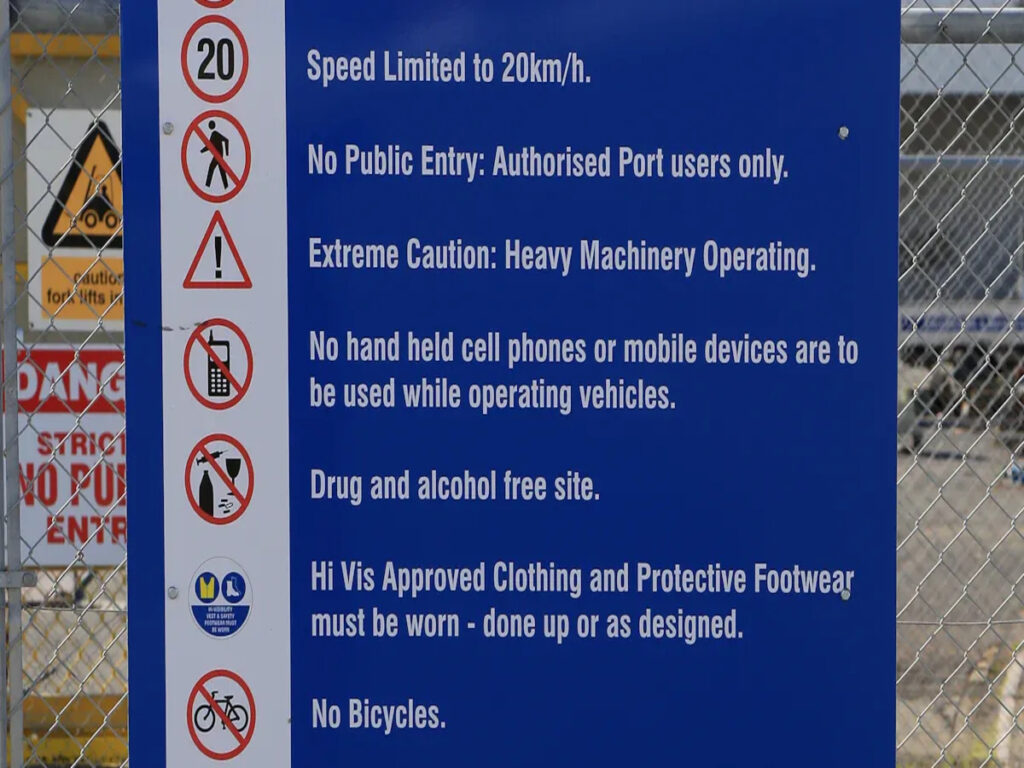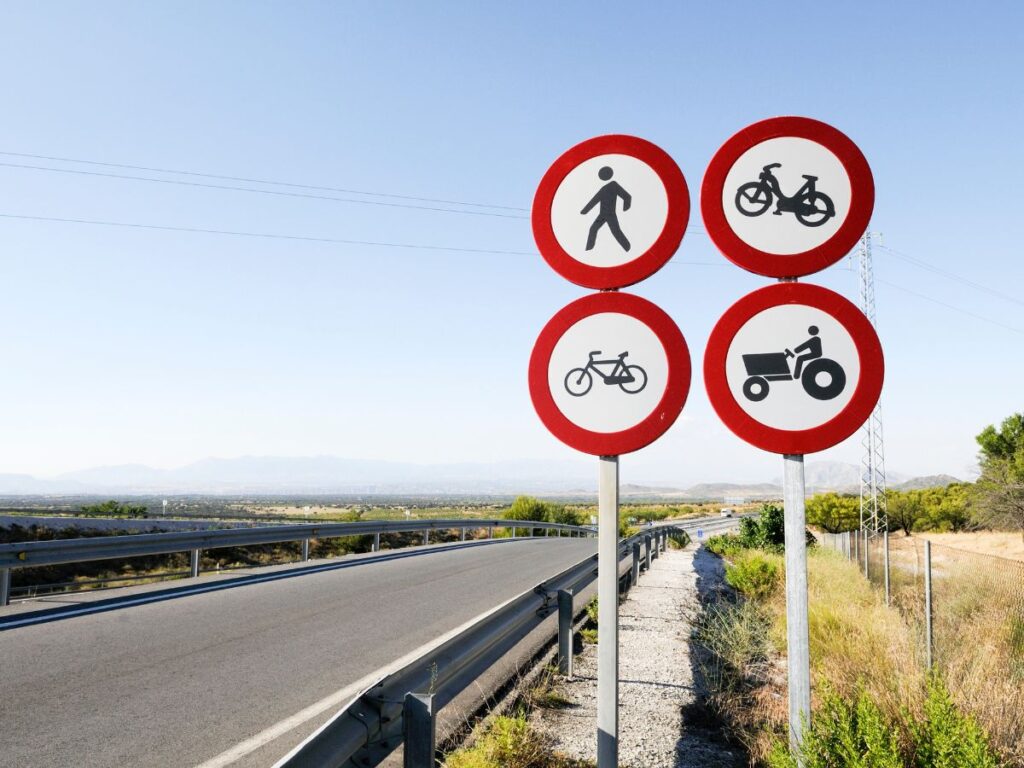
Utilizzi i simboli di pericolo GHS per mantenere sicuro il tuo posto di lavoro. Questi segnali e simboli di sicurezza avvisano di ogni pericolo. Sono presenti sulle etichette dei prodotti chimici e sulle schede di sicurezza. Questo ti aiuta a vedere rapidamente i rischi. In Australia e in altri paesi, i segnali e i simboli di sicurezza ti aiutano a seguire rigide regole di sicurezza. Mantieni la tua squadra e l'ambiente al sicuro conoscendo i simboli di pericolo. Inoltre, ogni giorno utilizzi i segnali e i simboli di sicurezza corretti.
OPTRAFFIC offre una varietà di prodotti conformi GHS Segni di sicurezza e simboli di pericolo progettati per garantire la sicurezza sul lavoro. I nostri segnali sono costruiti per soddisfare le normative locali e internazionali, aiutandoti a rimanere conforme proteggendo il tuo team e l'ambiente. Esplora oggi stesso la nostra gamma di soluzioni di segnaletica di sicurezza per mantenere un luogo di lavoro sicuro ed efficiente.
Panoramica sui simboli di pericolo GHS
Cosa sono i simboli di pericolo GHS?
Vedi Simboli di pericolo GHS sulle etichette dei prodotti chimici ogni giorno. Sono presenti anche sulle schede di sicurezza. Le Nazioni Unite hanno creato il sistema armonizzato a livello globale. Ti aiuta a conoscere rapidamente i rischi chimici. Ci sono nove pittogrammi principali. Ognuno si trova all'interno di una forma di diamante rosso. Ciascun pittogramma mostra un diverso tipo di pericolo. Trovi questi simboli sui contenitori e sulla segnaletica sul posto di lavoro. Sono presenti anche sulle etichette di trasporto. I simboli avvisano di pericoli quali infiammabilità o tossicità. Alcuni simboli avvertono dei danni all'ambiente.
I simboli di pericolo GHS sono più che semplici immagini. Sono dotati di avvertenze e indicazioni di pericolo. Riceverai anche consigli su come rimanere al sicuro. Questi simboli hanno sostituito i vecchi sistemi nazionali. Ora, ricevi lo stesso avvertimento in Australia o in qualsiasi altro paese. Puoi fidarti di questi simboli per informazioni chiare e rapide.
Utilizzi i simboli di pericolo GHS per individuare i rischi prima di maneggiare sostanze chimiche. Ti aiutano a scegliere i giusti dispositivi di protezione individuale. Ti aiutano anche a seguire le regole del lavoro sicuro. Quando vedi un simbolo, conosci il tipo di pericolo. Non è necessario leggere la lingua dell'etichetta.
Perché la standardizzazione è importante
La standardizzazione rende il tuo posto di lavoro più sicuro. Quando tutti usano gli stessi simboli di pericolo ghs, C'è meno confusione. Tu e il tuo team potete individuare rapidamente i pericoli. Questo è molto importante in caso di emergenza. Il sistema armonizzato a livello globale fornisce una serie di regole per le etichette e le schede di dati di sicurezza.
- I simboli standardizzati aiutano le persone che parlano lingue diverse.
- Ricevi avvisi rapidi sui rischi chimici.
- La formazione è più semplice perché tutti imparano gli stessi simboli.
- Si commettono meno errori e gli incidenti accadono meno.
| Elemento di sistema precedente | Elemento del sistema GHS |
|---|---|
| Scheda di sicurezza | SDS (Scheda dati di sicurezza) |
| Frasi di rischio | Dichiarazioni di pericolo |
| Frasi di sicurezza | Dichiarazioni cautelative |
| Etichette di classe DG | Pittogrammi GHS |
| N / A | Nuovi simboli degli effetti sulla salute |
Ora usi i simboli di pericolo ghs invece dei vecchi segnali. Questa modifica ti aiuta a rispettare le leggi sulla sicurezza in Australia e in altri paesi. Mantieni te stesso, la tua squadra, e l'ambiente in tutta sicurezza utilizzando queste regole chiare per i rischi chimici.
I nove pittogrammi GHS
Vedi Pictogrammi GHS al lavoro tutti i giorni. Questi simboli ti aiutano a individuare rapidamente i pericoli chimici. Ognuno mostra un diverso tipo di pericolo. Ci sono tre gruppi principali: salute, fisico, e rischi ambientali. Conoscere questi gruppi ti aiuta a rimanere al sicuro e a seguire le regole.
I pittogrammi GHS forniscono avvisi chiari. Li trovi sulle etichette, Schede di dati di sicurezza, e segni. Ti ricordano di maneggiare con cura i prodotti chimici ed evitare incidenti.
Pericoli per la salute
È importante sapere quali pittogrammi GHS avvertono dei rischi per la salute. Questi simboli mostrano quando una sostanza chimica può danneggiare il tuo corpo. Alcune sostanze chimiche causano problemi a breve termine. Altri possono farti del male per molto tempo. Ecco i principali pittogrammi di pericolo per la salute:
| Icona | Tipo di pericolo | Cosa significa |
|---|---|---|
| Pericolo per la salute | Rischi cronica per la salute | Può causare il cancro, problemi di respirazione, difetti alla nascita, o danni agli organi |
| Marco esclamativo | Pericolo acuto per la salute | Provoca irritazione alla pelle o agli occhi, problemi respiratori, o ti fa sentire sonnolento o stordito |
| Cranio e ossa incrociate | Tossicità grave | Prodotti chimici molto tossici; può causare la morte se ingerito, inalato, o assorbito |
| Corrosivo | Corrosivo per la pelle e gli occhi | Provoca ustioni alla pelle e agli occhi; può danneggiare anche i metalli |
Il simbolo di pericolo per la salute significa che una sostanza chimica può farti ammalare gravemente. Il punto esclamativo avverte di cose come eruzioni cutanee o vertigini. Il teschio e le ossa incrociate mostrano veleni molto pericolosi. Il simbolo corrosivo indica di fare attenzione alle ustioni e ai danni agli occhi.
Pericoli fisici
I pittogrammi di pericolo fisico avvertono di pericoli per cose o persone. Questi simboli ti aiutano a individuare le cose che possono bruciare, esplodere, o causare altri problemi. Ecco i principali pittogrammi di pericolo fisico:
| Icona | Tipo di pericolo | Cosa significa |
|---|---|---|
| Fiamma | Pericolo infiammabile | Sostanze infiammabili; possono prendere fuoco facilmente |
| Bomba che esplode | Pericolo esplosivo | Esplosivi o sostanze chimiche che possono esplodere |
| Fiamma sul cerchio | Pericolo di ossidazione | Prodotti chimici che accelerano la combustione o provocano incendi |
| Cilindro a gas | Gas sotto pressione | Gas immagazzinati sotto pressione; può esplodere o perdere liquido |
| Corrosivo | Corrosivo per i metalli | Danneggia metalli e contenitori |
Questi pittogrammi ti aiutano a individuare le sostanze chimiche che possono provocare incendi o esplodere. La fiamma significa che qualcosa può prendere fuoco. La bomba che esplode presenta un rischio di esplosione. La fiamma sopra il cerchio significa che una sostanza chimica può peggiorare gli incendi. La bombola del gas avverte dei gas che necessitano di un'accurata conservazione. Il simbolo corrosivo significa anche che alcune sostanze chimiche possono danneggiare il metallo.
Pericoli ambientali
I pittogrammi di pericolo ambientale avvertono delle sostanze chimiche che possono danneggiare la natura. Vedete questi simboli sulle sostanze chimiche dannose per l'ambiente. Ti aiutano a proteggere l'acqua, suolo, e gli animali dal male.
| Icona | Tipo di pericolo | Cosa significa |
|---|---|---|
| Ambiente (Pesce/Albero) | Pericolo ambientale | Nocivo per la vita acquatica e l'ambiente |
Questo simbolo ti aiuta a individuare le sostanze chimiche che possono inquinare fiumi e laghi. Ti ricorda di fare attenzione quando usi e butti via questi prodotti chimici. Pittogrammi GHS chiari come questo aiutano a fermare l'inquinamento. Mantieni la natura al sicuro seguendo questi avvertimenti.
I pittogrammi GHS ti aiutano a vedere rapidamente i pericoli. Puoi agire rapidamente per fermare gli incidenti e garantire la sicurezza di tutti.
Utilizzi questi pittogrammi per conoscere i rischi di ciascuna sostanza chimica. Ogni simbolo ti avvisa rapidamente di cosa potrebbe andare storto. Mantieni te stesso, la tua squadra, e l'ambiente sicuro imparando il significato di ciascun simbolo e seguendo le misure di sicurezza.
Segnaletica e simboli di sicurezza sul posto di lavoro
Comunicazione chiara
Ogni giorno vedi segnali e simboli di sicurezza sul lavoro. Queste immagini ti aiutano a notare rapidamente i pericoli. I pittogrammi GHS utilizzano simboli comprensibili a tutti. Non è necessario leggere lunghe etichette per conoscere i rischi. Le forme di diamante rosso sono facili da individuare. Questo sistema ferma la confusione, Anche se le persone parlano lingue diverse. I segnali e i simboli di sicurezza forniscono informazioni rapide. Puoi vedere il tipo di pericolo e sapere cosa fare. Parole di segnalazione come “Pericolo” o “Avvertenza” rendono le cose ancora più chiare. Viene visualizzato anche l'avviso, obbligatorio, e segnaletica di emergenza. Ognuno ha il suo colore e la sua forma. Questi simboli di sicurezza aiutano a prevenire gli errori e a mantenerti al sicuro.
I segnali e i simboli di sicurezza aiutano tutti a comprendere i pericoli. Ricevi avvisi rapidi in modo da poter agire rapidamente.
Consapevolezza dei lavoratori
Quando guardi i segnali e i simboli di sicurezza, presti più attenzione. Gli studi dimostrano che i lavoratori che conoscono i pittogrammi GHS sono più sicuri. Impari a individuare simboli per cose come il fuoco o il veleno. Questo ti aiuta a evitare incidenti e a mantenere tutti al sicuro. I segnali e i simboli di sicurezza ricordano di indossare indumenti protettivi. Ti mostrano dove trovare le uscite e il primo soccorso. Vedere questi simboli spesso ti aiuta a ricordare abitudini sicure.
- Segnali e simboli di sicurezza:
- Avvisarti dei pericoli e mostrare azioni sicure.
- Aiutarti a vedere la salute, fisico, e rischi ambientali.
- Ricordare ai lavoratori che potrebbero non conoscere tutti i rischi.
Formazione e Cultura della Sicurezza
Rendi il tuo posto di lavoro più sicuro imparando a conoscere i segnali e i simboli di sicurezza. Quando studi i pittogrammi GHS, capisci meglio i pericoli chimici. Allenarsi con questi simboli ti aiuta a ricordare cosa significano. Sai quando usare i guanti, occhiali, o altro attrezzo. La formazione di aggiornamento ti tiene aggiornato. Ti senti più sicuro nel segnalare pericoli o nel porre domande. Parlare apertamente rende il lavoro più sicuro per tutti.
L'uso della segnaletica e dei simboli di sicurezza nella formazione riduce gli incidenti e crea una forte cultura della sicurezza.
Una tabella può mostrare come interagiscono i diversi simboli di sicurezza:
| Tipo di simbolo | Scopo | Esempio di utilizzo |
|---|---|---|
| Pittogrammi GHS | Mostra i rischi chimici | Aree di stoccaggio dei prodotti chimici |
| Segnali di avvertimento | Avvertire i pericoli | Pavimento scivoloso |
| Segni obbligatori | Dirti cosa fare | Indossare una protezione per gli occhi |
| Segni di emergenza | Mostra uscite o pronto soccorso | Uscita antincendio, kit di pronto soccorso |
Mantieni sicuro il tuo posto di lavoro conoscendo e utilizzando tutti i simboli di sicurezza. I segnali e i simboli di sicurezza rappresentano la prima difesa contro i pericoli.
Simboli di pericolo GHS e conformità
Regolamenti australiani
In Australia, è necessario seguire rigide regole di sicurezza chimica. Le leggi sulla salute e sicurezza sul lavoro affermano che sono necessari i simboli di pericolo GHS su tutte le etichette dei prodotti chimici. Questi simboli ti aiutano a soddisfare gli standard di sicurezza nazionali. Li vedi come immagini nere all'interno di diamanti rossi su sfondo bianco. Ogni simbolo rappresenta un determinato pericolo, come sostanze chimiche infiammabili o tossiche.
Quando etichetti le merci pericolose, devi includere:
- Pittogrammi di pericolo GHS
- Avvertenze come “Pericolo” o “Avvertenza”
- Indicazioni di pericolo
- Dichiarazioni precauzionali
- Informazioni sul produttore
Alcuni prodotti, come piccole bottiglie di alcol o medicinali, non hanno bisogno di queste etichette. Se conservi molte merci pericolose, è necessario mostrare i cartelli HAZCHEM con la scritta rossa in grassetto. Per il trasporto, potresti utilizzare i pittogrammi del codice australiano delle merci pericolose. Questi devono corrispondere allo stesso pericolo del simbolo GHS.
Safe Work Australia crea leggi e codici di condotta modello in materia di salute e sicurezza sul lavoro. Ogni stato e territorio si assicura che queste regole vengano seguite. Devi classificare, etichetta, e fornire schede di sicurezza per ogni sostanza chimica presente sul lavoro. Questo sistema mantiene il tuo posto di lavoro sicuro e impedisce la confusione.
Vantaggi legali e di sicurezza
Se segui le regole GHS, ottieni una forte protezione legale e una migliore sicurezza. Riduci il rischio di multe e problemi legali utilizzando le etichette chimiche e i simboli di pericolo corretti. Inoltre rendi il tuo posto di lavoro più sicuro per tutti.
| Vantaggio legale | Spiegazione |
|---|---|
| Conformità alle leggi WHS armonizzate | Segui le leggi nazionali sulla sicurezza in tutta l'Australia. |
| Riduzione dei rischi legali | Eviterete sanzioni e problemi legali derivanti da una cattiva gestione dei prodotti chimici. |
| Comunicazione del pericolo standardizzata | Usi gli stessi simboli ovunque, quindi le regole sono facili da seguire. |
| Allineamento ai codici di condotta | Segui le guide approvate dagli enti regolatori per la sicurezza chimica. |
| Mitigazione degli oneri normativi | Risparmiate tempo e fatica utilizzando un unico sistema per tutte le merci pericolose. |
Quando si utilizzano i simboli di pericolo GHS, tutti coloro che lavorano possono individuare rapidamente i pericoli chimici. Etichette chimiche chiare e segnali di sicurezza aiutano a prevenire gli incidenti e a mantenere in salute la tua squadra. Inoltre risparmi denaro evitando infortuni, tempo di lavoro perso, e richieste di risarcimento. Molte industrie in Australia, come l'estrazione mineraria, produzione, e trasporti, utilizzare queste regole per garantire la sicurezza dei lavoratori e dell’ambiente. Seguendo il GHS, rendi anche più semplice il commercio di merci pericolose con altri paesi, perché tutti utilizzano lo stesso sistema di sicurezza.
Una buona sicurezza inizia con simboli di pericolo chiari. Proteggi la tua squadra, la tua attività, e l’ambiente seguendo queste regole.
Rendi il tuo posto di lavoro più sicuro quando conosci i simboli di pericolo GHS. Questi simboli ti aiutano a vedere rapidamente i pericoli. La sicurezza diventa parte di ciò che fai ogni giorno.
| Area di beneficio | Impatto a lungo termine sulla sicurezza |
|---|---|
| Aziende | Meno incidenti, regole più facili da seguire, Risparmia |
| Lavoratori | Scopri di più sui pericoli, farti male di meno |
| Ambiente | Maneggiare i prodotti chimici in modo sicuro, Meno inquinamento |
Contribuisci a costruire un luogo di lavoro sicuro restando attento. Impari nuove regole di sicurezza e chiedi aiuto agli esperti.
Domande frequenti
Cosa fare se vedi un simbolo di pericolo GHS che non riconosci??
Dovresti fermarti e controllare la scheda dati di sicurezza (SDS) per quella sostanza chimica. La scheda di sicurezza spiega ciascun simbolo e indica quali passaggi eseguire. Chiedi sempre al tuo supervisore se non ti senti sicuro.
Hai bisogno di una formazione speciale per comprendere i simboli di pericolo GHS?
Non hai bisogno di una formazione avanzata. Nella maggior parte dei luoghi di lavoro viene fornita una formazione di base sulla sicurezza. Imparerai cosa significa ogni simbolo e come rimanere al sicuro. I corsi di aggiornamento ti aiutano a ricordare i simboli.
Dove trovi i simboli di pericolo GHS sul tuo posto di lavoro?
Vedete i simboli di pericolo GHS sui contenitori di prodotti chimici, aree di stoccaggio, e schede di sicurezza. Li trovi anche sui segnali di pericolo vicino a materiali pericolosi. Questi simboli ti aiutano a individuare rapidamente i pericoli.
Perché è necessario aggiornare le vecchie etichette chimiche con i simboli GHS?
È necessario aggiornare le vecchie etichette per seguire le attuali leggi sulla sicurezza. I simboli GHS ti danno chiaro, avvertenze standard. Ciò aiuta tutti sul posto di lavoro a comprendere i rischi e a rimanere al sicuro.

















